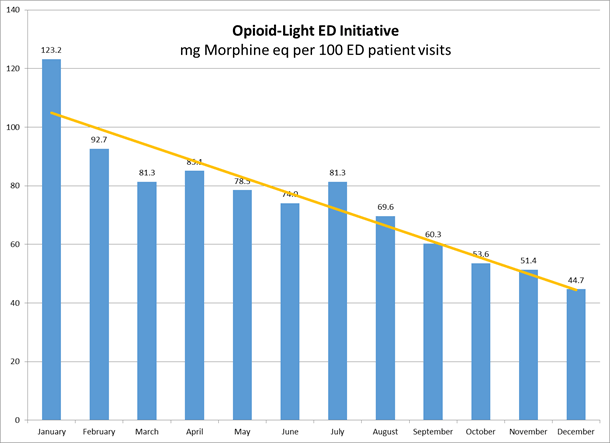
5/11/2018
Baptist Memorial Healthcare, Memphis, TN
Opioid-light initiative: A multi-modal approach to reduce opioid prescribing in the emergency department
Overview
Tennessee ranks second nationally in opioid-related deaths — approximately 80 percent involve prescription opioids. Due to the alarming rate of opioid use and associated overdoses in our state, we assembled a team of pharmacists and physicians to address the Centers for Disease Control and Prevention (CDC) and the Tennessee Department of Health initiatives to decrease opioid addiction.A patient’s first opioid exposure often occurs during an emergency department (ED) visit. Two studies published in the Annals of Emergency Medicine (Hoppe et al., 2015; 65: 493-499 and Butler et al., 2016; 68: 209-212) demonstrated an association between prescription opioid initiation in the ED as an initial exposure preceding addiction and recurrent opioid use. This prompted us to focus on improving opioid prescribing patterns in our ED. We developed a multimodal pain therapy order set to provide alternative treatment options for five specific indications with supporting evidence for efficacy of non-opioids. The “opioid-light” order set included alternative therapies for migraine or headache, musculoskeletal pain, joint fracture or dislocation, renal colic, and chronic abdominal pain. In addition, we evaluated individual prescribing patterns to target opportunities for additional education to high-use providers.
The goal was to decrease patient exposure to opioids in our ED while improving patient care through education and encouraged use of alternative medications.

Key Elements of Success
Approvals of the ED Service Line and Pharmacy & Therapeutics Committees were obtained for implementation of the “opioid-light” order set. Pharmacists educated providers and nurses on the order set and alternative medication options. Order set medications were made available in the automated dispensing machines for increased accessibility. We also worked with leadership to develop policy and training to allow ED nurses to administer low, analgesic doses of ketamine.
Milligrams of morphine equivalents per 100 ED patient visits (MME/100) was chosen as the primary metric. Individual provider patterns were evaluated for overall opioid usage, percent of patients prescribed opioids, and selection and dose of opioid agent prescribed.Impact on Patient Outcomes
As a result of our initiative, we achieved a 64% reduction in ED opioid usage from January to December of 2017. In addition to overall opioid usage, we also decreased the number of patients receiving opioids by 41%. See graph for ED opioid usage from January to December of 2017. We also saw an increase in patient satisfaction scores. This was especially reassuring as providers had initial concerns that patients would express dissatisfaction with their care if not receiving opioid pain medications. We now have patients specifically asking not to receive opioids.
Role of the Pharmacy and Pharmacists
A focused pharmacy team consisting of our director, clinical manager, ED pharmacists, operations pharmacists, and clinical pharmacists met multiple times weekly to evaluate data, identify obstacles, discuss ideas, and plan future steps through a Kata improvement process. Pharmacists were responsible for order set development, prescriber and nursing education, data collection and analysis, and communication of results with the ED medical director and care team. Pharmacists also had one-on-one discussions with high-usage providers to address barriers and provide recommendations.Lessons Learned
The combined approach of alternative therapies and data tracking was vital. Many providers preferred agents other than opioids. We empowered them to better care for patients by providing education and evidence-based alternative treatment pathways. Other clinicians responded to numbers, as data brought visibility to high-usage providers. However, this visibility would not have had significance without a physician leader willing to set a higher standard of care and provide peer-to-peer feedback. An interdisciplinary approach and patient engagement were needed, with nurses and providers discussing alternative medications and risks of opioids with patients. Our administration supported these efforts and addressed providers’ initial concerns regarding patient satisfaction. We unexpectedly saw an increase in both overall patient satisfaction scores and those related to pain.Budget & Resource Allocation
We used the innovative Kata process to identify barriers and experiment with new methods throughout the opioid-light project. Pharmacy members of our team were Kata trained. Also, our approach was not to restrict opioid use, but rather to promote multimodal non-opioid approaches as first line therapy. We chose to avoid restricting alternatives such as IV acetaminophen and provided higher cost, but lower dose syringes of hydromorphone. We felt any additional medication costs were greatly outweighed by reduction in opioid usage.Future Goals
The results of our opioid-light initiative were presented at the Tennessee Hospital Association (THA) Leadership Summit on October 11, 2017, in Nashville. The results were well-received and we are now collaborating with THA to create a plan to implement the opioid-light program statewide. Additionally, our ED Medical Director and ED Lead Pharmacist were invited to join the Tennessee Opioid Taskforce. We are also working to expand this work to our own 22-hospital system in Tennessee, Mississippi, and Arkansas. At our own hospital, we have expanded our focus to perioperative pain management.